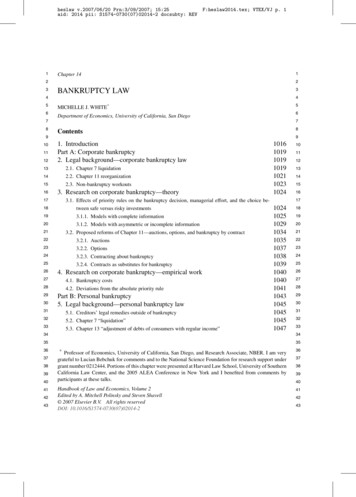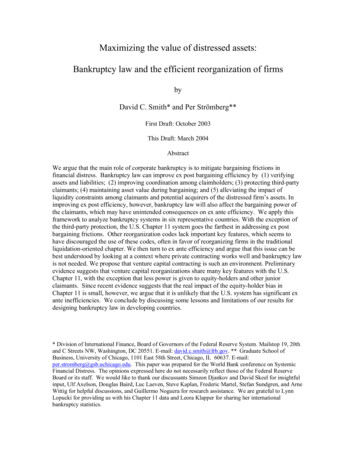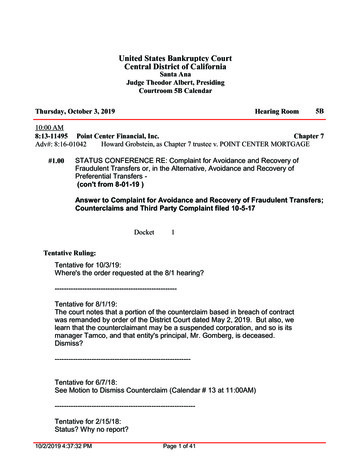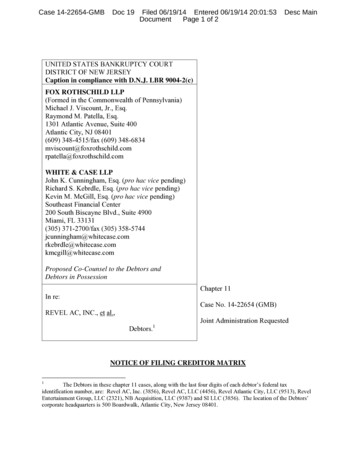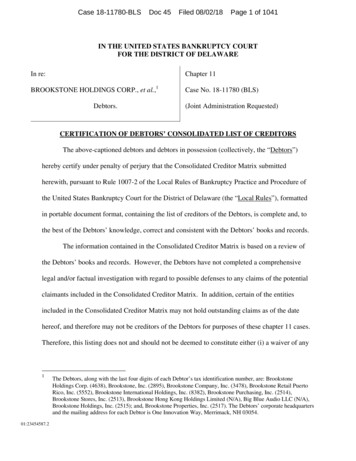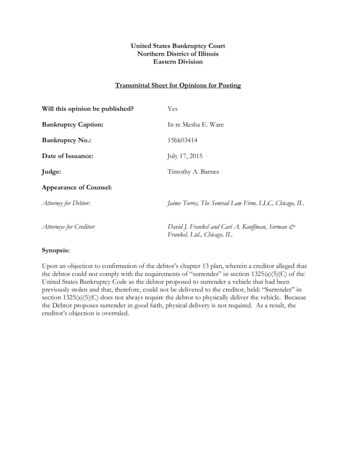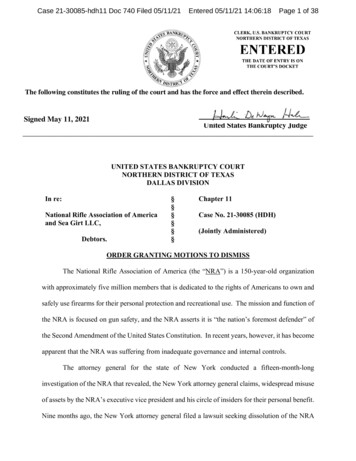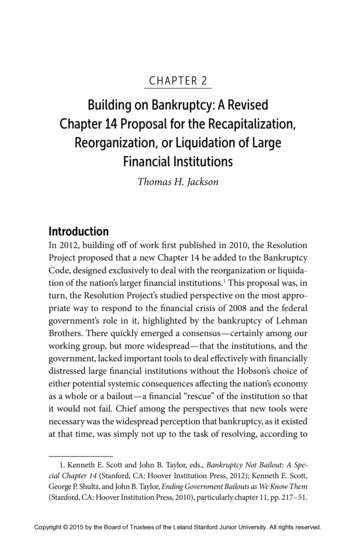
Transcription
CHAPTER 2Building on Bankruptcy: A RevisedChapter 14 Proposal for the Recapitalization,Reorganization, or Liquidation of LargeFinancial InstitutionsThomas H. JacksonIntroductionIn 2012, building off of work first published in 2010, the ResolutionProject proposed that a new Chapter 14 be added to the BankruptcyCode, designed exclusively to deal with the reorganization or liquidation of the nation’s larger financial institutions.1 This proposal was, inturn, the Resolution Project’s studied perspective on the most appropriate way to respond to the financial crisis of 2008 and the federalgovernment’s role in it, highlighted by the bankruptcy of LehmanBrothers. There quickly emerged a consensus—certainly among ourworking group, but more widespread—that the institutions, and thegovernment, lacked important tools to deal effectively with financiallydistressed large financial institutions without the Hobson’s choice ofeither potential systemic consequences affecting the nation’s economyas a whole or a bailout—a financial “rescue” of the institution so thatit would not fail. Chief among the perspectives that new tools werenecessary was the widespread perception that bankruptcy, as it existedat that time, was simply not up to the task of resolving, according to1. Kenneth E. Scott and John B. Taylor, eds., Bankruptcy Not Bailout: A Special Chapter 14 (Stanford, CA: Hoover Institution Press, 2012); Kenneth E. Scott,George P. Shultz, and John B. Taylor, Ending Government Bailouts as We Know Them(Stanford, CA: Hoover Institution Press, 2010), particularly chapter 11, pp. 217–51.Copyright 2015 by the Board of Trustees of the Leland Stanford Junior University. All rights reserved.
16 Thomas H. Jacksonthe rule of law, such institutions in a fashion that would contain systemic effects.This conclusion was the result of a number of subsidiary beliefs—some correct, some not. The bankruptcy process was too slow andcumbersome. The adversarial bankruptcy process was conductedbefore a judicial officer who might know the law, but didn’t havethe requisite economic or financial expertise or the power to consider systemic consequences. Bankruptcy had too many exclusionsto deal effectively with a complex financial group (depository banksand insurance companies were wholly excluded; stockbrokers andcommodity brokers were assigned to a specialized provision of Chapter 7).2 And a series of amendments to the Bankruptcy Code, originally driven by the International Swaps and Derivatives Association(ISDA) and the Federal Reserve Board, had increasingly immunizedcounterparties on qualified financial contracts from the major consequences of bankruptcy, prominently including bankruptcy’s automaticstay under section 362.3While members of the Resolution Project believed that a numberof those criticisms were justified, we also believed that thoughtfulrevisions to the Bankruptcy Code could ameliorate or eliminate manyof them, improving the prospect that our largest financial institutions—particularly with pre-bankruptcy planning—could be reorganized or liquidated pursuant to the rule of law (especially respectingpriorities to ensure that losses fell where they were anticipated). Outof that grew our proposal for a special chapter designed for suchfinancial institutions: a Bankruptcy Code Chapter 14.4 Key featuresin that proposal included: (a) allowing an entire covered financialinstitution, including its non-bank subsidiaries, to be resolved inbankruptcy without the existing Bankruptcy Code’s potpourri of2. These criticisms are outlined more fully in Scott et al., Ending GovernmentBailouts, 218.3. Criticized both in Scott and Taylor, Bankruptcy Not Bailout, 45–46; and inDavid Skeel and Thomas Jackson, “Transaction Consistency and the New Financein Bankruptcy,” Columbia Law Review 112 (2012): 152.4. See Scott and Taylor, Bankruptcy Not Bailout.Copyright 2015 by the Board of Trustees of the Leland Stanford Junior University. All rights reserved.
Building on Bankruptcy17exemptions; (b) the ability of the institution’s primary regulator,who may be aware of potential systemic consequences otherwise notbefore a bankruptcy court, to file an involuntary petition, includingone based on “balance sheet” insolvency, as well as to have standingto be heard as a party or to raise motions relevant to its regulation,including filing a plan of reorganization notwithstanding a debtor’sexclusive period and motions for the use, sale, and lease of property; (c) numerous changes to the protections afforded by existingbankruptcy law to holders of qualified financial contracts, especiallyderivatives and swaps, to ensure that they were treated according totheir basic underlying attributes (that of secured liabilities, in the caseof repos; that of executory contracts, in the case of derivatives andswaps); (d) provisions allowing, with designated protections againstfavoritism or bailout, funding for the pre-payment of certain distributions to identified creditors; and (e) the assignment of Chapter 14cases and proceedings to designated Article III district judges, ratherthan to bankruptcy judges without the political independence provided by Article III.5In proposing this, we wrote:We, the members of the Resolution Project group, believe it is possiblethrough these changes to take advantage of a judicial proceeding—including explicit rules, designated in advance and honed throughpublished judicial precedent, with appeals challenging the applicationof those rules, public proceedings, and transparency—in such a way asto minimize the felt necessity to use the alternative government agencyresolution process recently enacted as a part of the Dodd-Frank WallStreet Reform and Consumer Protection Act. The new chapter couldbe adopted either in addition or as an alternative to the new resolutionregime of Dodd-Frank.The crucial feature of this new Chapter 14 is to ensure that thecovered financial institutions, creditors dealing with them, and othermarket participants know in advance, in a clear and predictable way,how losses will be allocated if the institution fails. If the creditors of a5. For more detail, see ibid., 26–70.Copyright 2015 by the Board of Trustees of the Leland Stanford Junior University. All rights reserved.
18 Thomas H. Jacksonfailed financial institution are protected (bailed out), then the strongestand most rapidly responding constraint on risk taking by the financialinstitution’s management is destroyed, and their losses are transferredto others.6Even with the passage of the Dodd-Frank Wall Street Reform andConsumer Protection Act of 2010,7 with its own Title II resolution process run by the Federal Deposit Insurance Corporation—the OrderlyLiquidation Authority—we believe these changes to bankruptcy lawremain vital to accomplish several of the announced goals of DoddFrank itself. First, Title I’s resolution plans—which we believe are animportant part of pre-bankruptcy planning—require a focus on usingbankruptcy as the standard against which their effectiveness will bemeasured.8 And, second, invocation of Title II itself can only occur ifthe government regulators find that bankruptcy is wanting.9 Unlessbankruptcy can be seen as a viable alternative for the resolution of alarge and complex systemically important financial institution (SIFI)in economic distress, (a) the resolution plans could technically befound not credible or facilitating an orderly liquidation (since theyare to be based on bankruptcy) and (b) breakup, or use of Title II ofDodd-Frank, will be the only perceived effective responses to the “toobig to fail” problem.10Those remain important reasons for the adoption of many of theproposals the Resolution Project put forth in its original 2012 Chapter 14 proposal. That proposal, however, consistent with most of6. Ibid., 26.7. Pub. L. No. 111-203, 124 Stat. 1376 (Dodd-Frank Act).8. Dodd-Frank Act, section 165(d). The ways in which a proposal such asthe one contained in this chapter would bring congruity to those provisions isexplored in William Kroener, “Revised Chapter 14 2.0 and Living Will Requirements under the Dodd-Frank Act,” chapter 8 in this volume.9. Ibid., sections 203(a)(1)(F) and (a)(2)(F); sections 203(b)(2) and (3).10. Reducing the size, and not just the complexity, of large financial institutionsmay be independently desirable, but that goal—if indeed it is one—should not beconflated with designing an appropriate mechanism for the effective resolution ofa financial institution in distress.Copyright 2015 by the Board of Trustees of the Leland Stanford Junior University. All rights reserved.
Building on Bankruptcy19the thinking and work being done at that time, was focused on theresolution of an operating institution—which, in the case of a largefinancial institution, is usually at the subsidiary level of a holdingcompany. Yet, in addition to the concerns with existing bankruptcylaw, Title II, as enacted, had its own set of difficulties with effectiveresolution of any such financial institutions. Title II is designated the“Orderly Liquidation Authority,”11 and section 214(a) explicitly states:“All financial companies put into receivership under this subchaptershall be liquidated.”12 A first-day lesson in a corporate reorganizationcourse is that “understanding that financial and economic distress areconceptually distinct from each other is fundamental to understanding Chapter 11 of the Bankruptcy Code.”13 Thus, what of a companywhose going-concern value exceeds its liquidation value? But if bankruptcy is perceived not to be up to the task and Title II required anactual liquidation of the business, there may be many cases in whichthe condition precedent for the use of Title II—that it will be moreeffective than bankruptcy—will not be met, and current bankruptcywill (or, under the terms of Dodd-Frank, should) be the (rather inefficient) result.Since then, however, a sea change in perspective has occurred.14Increasingly, the focus, in Europe as well as in the United States, has beenon a reorganization or recapitalization that focuses, in the first instance,on the parent holding company (many or most of the assets of whichare the equity ownership of its subsidiaries). Europe has focused on a11. Dodd-Frank Act sections 206 and 208 (emphasis added).12. Ibid., section 214(a). See also Thomas Jackson and David Skeel, “DynamicResolution of Large Financial Institutions,” Harvard Business Law Review 2 (2012):435, 440–41.13. Barry Adler, Douglas Baird, and Thomas Jackson, Bankruptcy: Cases, Problems, and Materials, 4th ed. (St. Paul, MN: Foundation Press, 2007), 28.14. A useful discussion of whether and how well Title II of Dodd-Frank wouldhave responded to the 2008 crisis—prior to the development of the SPOE proposal—is contained in David Skeel, “Single Point of Entry and the BankruptcyAlternative,” in Across the Great Divide: New Perspectives on the Financial Crisis(Stanford, CA: Hoover Institution Press, 2014). Cf. Emily Kapur, “The Next Lehman Bankruptcy,” chapter 7 in this volume.Copyright 2015 by the Board of Trustees of the Leland Stanford Junior University. All rights reserved.
20 Thomas H. Jackson“one-entity” recapitalization via bail-in15 while the FDIC has focused inits single-point-of-entry (SPOE) proposal on a “two-entity” recapitalization.16 Under the FDIC’s approach, a SIFI holding company (the “singlepoint of entry”) is supposed to effectively achieve “recapitalization” ofits business virtually overnight by the transfer of its assets and liabilities,except for certain long-term unsecured liabilities and any subordinateddebt, to a new bridge institution. The bridge institution then is supposedto forgive intercompany liabilities or contribute assets to recapitalizeits operating subsidiaries. Because of the splitting off of the long-termunsecured debt, the bridge institution, in the FDIC’s model, looks verymuch like a SIFI holding company following a European-like bail-in.The major difference is that in the bail-in, the SIFI holding companybefore and after the recapitalization is the same legal entity (thus, theone-entity recapitalization), whereas in the FDIC’s SPOE proposal, therecapitalized bridge institution is legally different than the pre-SPOESIFI holding company (thus, the two-entity recapitalization).There are preconditions for making this work. Important amongthem are legal rules, known in advance, setting forth a requiredamount of long-term debt to be held by the holding company thatwould be legally subordinate to other unsecured debt—in the senseof being known that it would be bailed-in (in a one-entity recapitalization) or left behind (in a two-entity recapitalization).17 And its15. Financial Stability Board, Progress and Next Steps Towards Ending “Too-Bigto-Fail,” Report of the Financial Stability Board to the G-20, September 2, r 130902.pdf; Thomas Huertas,“The Road to Better Resolution: From Bail-out to Bail-in,” speech at The Euroand the Financial Crisis Conference, September 6, 2010, es/2010/0906 th.shtml; Christopher Bates andSimon Gleeson, “Legal Aspects of Bank Bail-Ins,” Clifford Chance client briefing,May 3, 2011.16. FDIC SPOE, Federal Deposit Insurance Corporation, The Resolution ofSystemically Important Financial Institutions: The Single Point of Entry Strategy,78 Fed. Reg. 76614 (Dec. 18, 2013).17. See Kenneth E. Scott, “The Context for Bankruptcy Resolutions,” chapter 1in this volume; see also John Bovenzi, Randall Guynn, and Thomas Jackson, “TooBig to Fail: The Path to a Solution,” panel discussion, Bipartisan Policy Center,Failure Resolution Task Force, Washington, DC, May 2013.Copyright 2015 by the Board of Trustees of the Leland Stanford Junior University. All rights reserved.
Building on Bankruptcy21effective use in Title II—as of this writing the FDIC has promulgatedfor comments a working document on
Project proposed that a new Chapter 14 be added to the Bankruptcy Code, designed exclusively to deal with the reorganization or liquida- tion of the nation’s larger financial institutions. 1 This proposal was, in
